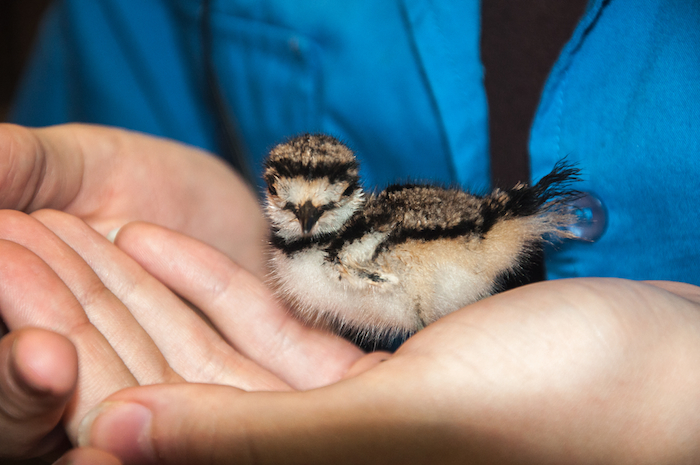Handling baby birds is appealing, but this killdeer would probably be better off left with its parents. More often than not, “A bird in the bush is worth two in the hand.”

Spring is in the air, and soon, if not already, the birds will be paired up, laying their eggs and raising their babies.
The birds most of us are familiar with have Altricial babies. That means when they hatch they are helpless, naked, and blind. This is the Nestling stage. The parents will work very hard during this time to provide food for them. Within a couple of weeks they will have feathers and will be exercising their muscles by flapping their wings very rapidly.
The next stage is called Fledgling. At this stage, the young will drop to the ground and run around, getting more exercise and hiding where they can. They are only in this state for about a week, waiting for their wing and tail feathers to grow a little longer, which will enable them to fly up and travel with their parents to find food and learn the art of survival. The parents recognize the cries of each individual baby and continue to feed them.
While the fledglings are on the ground they get preyed on by cats, dogs and picked up by humans who think they are orphaned and need help. Most of the time, as long as pets are controlled, they don’t need to be “rescued.”
The other type of baby bird is called Precocial. When these birds hatch and dry off, they are ready to follow their parents and start foraging for food on the ground right away. Precocials include quail, pheasants, turkeys, killdeer, and water birds that are here in our area. The baby killdeer in this area seem especially susceptible to being picked up because humans mistakenly think they are orphaned. They’re small, fluffy, and are known to hatch in open areas like parks, where they come into contact with people more often than the other Precocial birds. The baby killdeer and their parents wander from spot to spot, eating whatever insects they can find. When they are threatened, the parents have a particular sound that tells the babies to hunker down and be quiet. The only way you can see them is if you accidentally flush them out. If that happens, just quickly leave the area. If left alone, the parents will signal the All Clear and everyone will start walking around again, ready to eat their fill of whatever insects are out there.
We all have the best of intentions when we see an animal in danger. However, before we intervene, it’s always best to make sure that the bird is really in need of help. Fledgling birds usually need to be left alone so that they can continue to be in the care of their parents. Infant Precocial birds have the best chance of survival if allowed to continue to be raised by their parents.
Keep your cats and dogs indoors or restrained, and try watching at a distance for about a half hour to see if the parents are around. You will find that many of these youngsters are OK just where you left them. If not, please call Shasta Wildlife Rescue & Rehabilitation at 530-365-9453 and get advice on the situation before you physically intervene.
Thanks to author Karlene Stoker of Shasta Wildlife Rescue and Rehabilitation. To volunteer with Shasta Wildlife call 347-3630
